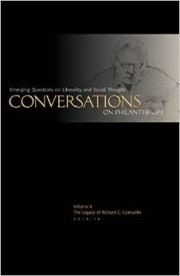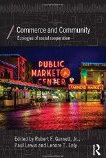Markets, Entitlement and The Ethos of Modern Philanthropy
Writing in The Public Discourse last week (A Moral Foundation for Entitlement Reform), Adam MacLeod proposes that charity forms sympathetic bonds between donors and their recipients in ways that government entitlement payments cannot:
Acts of sharing and exchange within the family establish moral connections. Parents have natural obligations to provide for their children. Children who are dependent upon their parents owe to their parents obligations of obedience when young, and honor and respect in mature age.
Charitable acts function in the same way, though less comprehensively than acts of sharing within families. When one gives a gift to a friend, buys a sandwich for a homeless person, or makes a donation to a scholarship fund at one’s alma mater, the reason for the gift is the wellbeing of the recipient. The donor perceives a human being or community of human beings and chooses to make their wellbeing his own goal to be achieved. The donor takes the life and plans of the recipient into his own reasoning, and thereby into his character.
Like familial obligations, then, a gift changes both the donor and the recipient for the better by focusing their attention on the wellbeing of someone else. The donor becomes someone who acts for the good of another. The recipient becomes a matter of concern to another human being. The investment that the donor makes in the life of the recipient gives the recipient a reason to live well not only for his own sake but also for the sake of the donor.
MacLeod is onto something here, and one should read as well his follow-up essay (Principled Entitlement Reform: Private Ordering Needs Room to Grow), in which he embarks on a defense of private law as an important space in which social order is shaped in a free society:
The basic problem with entitlements is that they corrupt our understanding of law and civic ordering. Whoever has responsibility to distribute resources must have the authority to decide on what terms the resources will be distributed. Thus, once we accept the idea that government has primary responsibility to provide for material needs, we inexorably accept the idea that government has primary responsibility to order civic affairs.
This jeopardizes the moral development of communities and their members. Public law crowds out private law and eliminates the possibility of collaboration, compromise, and communal deliberation in the use and management of resources. In this way it suffocates the moral agency of citizens.
We need to look more closely at the spectrum of moral obligation upon which MacLeod’s argument seems to turn. This spectrum would seem to arrange human relations in order from those that inculcate the most interpersonal knowledge and obligation to those that invert the development of mutual moral obligation into an entitlement held by one party. Families thus forge the thickest bonds, and traditional charitable giving would fall next. Markets, on MacLeod’s account, are capable of fostering only thinner bonds (“Market institutions are not equipped to function like families, and it is not surprising that they have proven unable to bear the weight placed upon them as families have disintegrated.”). Welfare state bureaucracies would seem to hold the polar position on the opposite end of this spectrum from the family, not merely failing to serve what Kenneth Boulding described at “integrative” social functions, but also to weaken or destroy integrative institutions. Writes MacLeod, “The regulatory state can tolerate private ordering only as long as privately ordered institutions (such as churches and charities) stay out of its way. So, beyond the economic costs of expansive public entitlements, and the moral hazards they pose, there lurks the additional danger of crowding out the very institutions that our society needs in order to flourish.”
One problem I see with this spectrum array is that while accounting for traditional forms of charitable beneficence, MacLeod doesn’t seem to address the ways that modern philanthropy has increasingly worked. Today, donors more often donate to nonprofit organizations that act as intermediaries between donors and recipients than hit the pavement themselves with baskets of food for the hungry or ill. The modern philanthropist may glean little interpersonal knowledge of and obligation to known recipients of their aid and may be more likely to forge relationships with other donors at charity balls or with professional fundraisers than with the “clients” of the nonprofit agency.
While volunteerism remains strong in America and can help ameliorate the impersonal nature of much giving today, in fact the ethos of modern philanthropy is often marked much more by abstract relationships between donors and the social problems they hope to solve than by personal relations between donors and those in need. In this way, modern philanthropy, both in its emphasis on “strategic philanthropy” and “donor intent” and its reliance upon charitable intermediaries, often shades more toward the impersonal side of the spectrum of moral obligation that MacLeod seems to lay out.
This is likely not a fatal problem with MacLeod’s argument, which is on the whole asking much needed questions. But it is one that we must take into account, and it is these sorts of questions that The Philanthropic Enterprise seeks to address. Can moral obligations be generated in the abstract spaces of markets and modern philanthropy? If so, how? Since the mid-19th century, critics of capitalism have argued that markets in fact work to dissolve moral obligations and social orders and that the welfare state is needed to positively support “social justice.” (An older and perhaps more honest term was “social control.”)
From our vantage point today, we have begun to understand how market processes in fact promote social learning and foster socially beneficent virtues (property rights, the honoring of contracts, and even the negotiation of prices between buyer and seller all seem to inculcate the respect for others incumbent in the Golden Rule). We are also beginning to document and explain, as MacLeod does, how the impersonal entitlements generated by the welfare state have been an even more destructive solvent of the reciprocities of moral sympathy and personal identification in our society than the processes of market production and exchange. To these efforts, we also are beginning to understand how the social philosophy of the market process, far from inclining people to rampant predatory individualism, has allowed abundant space for the coexistence of voluntary relationships in non-market institutions. The family, the lodge, the mutual aid society, the church, the local charitable organization… all of these social institutions posed threats to the totalitarian vision embodied in Communism, socialism, fascism, and forms of social democracy that have relied upon “welfare” institutions of the state. None of these voluntary social institutions inherently threatens the market, until, as has increasingly happened in the Atlantic world, they absorb the ideology of the welfare state and become its beneficiaries and chief apologists.
To MacLeod’s helpful discussion, we must add a serious public choice analysis of the realignment of our charitable organizations with the welfare state. Understanding the role of philanthropy in political economy, in theory and practice, is imperative if we are to strengthen the institutions that best foster a good society. We mustn’t reduce our study of human action to economic paradigms–There are more things in heaven and earth than can be explained by economic tools of analysis—but the economic way of thinking can certainly help us clear some of the chaff from the wheat, allowing for our moral and philosophical deliberations to focus on the questions most helpful in our quest to explain and defend the beneficence of liberty and the important liberty of beneficence.




